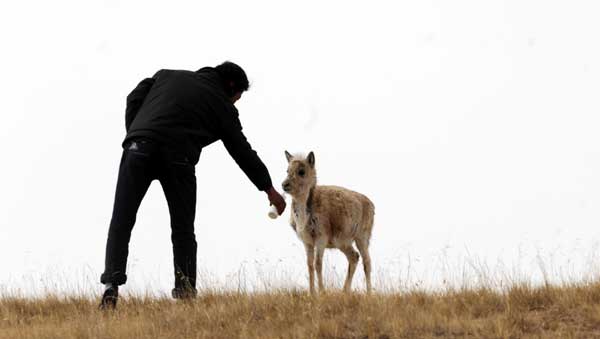Photos
More efforts to protect Tibetan antelopes
Updated: 2011-05-10 15:56
(Xinhua)
|
 |
|
A man feeds milk to a Tibeten antelope in Hol Xil or the Kekexili Reserve, Qinghai province in this April 1, 2011 file photo. [Photo/Xinhua] |
Hoh Xil - Four nature reserves, covering 550,000 square kilometers in west China, are joining hand in hand to protect the endangered Tibetan antelopes through anti-poaching operations scheduled to begin in late May.
"The joint anti-poaching operation is expected to last for one to three months and will become an annual routine," said Tseta, party chief of the Hoh Xil National Nature Reserve Administration.
The joint patrol will also be the first time for the four zones to work together and is considered to be the largest protection campaign since the nature reserve was established in the 1990s, he said.
| ||||
"The protection work used to be cut into pieces and illegal hunters had been seeking loopholes to travel through the four zones to hunt and avoid being hunted," he said.
The Tibetan antelopes, a first class national level protected animal, live on the Qinghai-Tibet Plateau at an average altitude of 4,600 to 6,000 meters. China once had millions of Tibetan antelopes, but excessive hunting and human encroachment on their habitat caused their population to plummet in recent decades.
Also, international traffickers hunted the antelopes to make shawls, a luxury item that required three to five pieces of antelope fur to make just one shawl.
Since 1979, the animal has been recognized as an endangered species and protected under the Convention on the International Trade in Endangered Species. However, gunshots were heard continuously as greedy hunters chased the profits from the animals' pelts.
A protection station was set up in 1996 in Hoh Xil, two years after gunshots killed Sonam Dargye, who tried to protect antelopes in 1994. The Hoh Xil National Nature Reserve, as well as the administration, was established in 1997.
More than 400 patrols have been carried out in which over 3,500 people had patrolled one million kilometers to protect the animals over the last 13 years, Tseta said.
"No gunshots have been heard in the past five years and the illegal hunting has been largely restrained while new problems have came to us, which forced us to unite," he said.
Hunters began to hire native herdsmen to help hunt, which is much more separated and hidden from view, said Shira, director of Forest Public Security Bureau of Tibet Changtang Nature Reserve.
"The area is too broad and barely populated, which brought great difficulties to us and many chances to hunters," Shira said.
No hunting had been discovered during patrolling in recent years, though small scale hunting might still exist. "I dare not say that hunting has been terminated in the four reserves," he said.
"Antelopes migrate across the four zones and so do the hunters, but we cannot execute the law across the board. Clues used to be cut off when hunters fled to another reserve," said Luo Yanhai, director of the Forest Public Security Bureau of Hoh Xil administration, who had been a patrolling team member for ten years.
A system of joint patrolling will be established according to the assignment. Except for patrolling, habitat protection, scientific research, information sharing and cross-zone manhunts will each be carried out annually. Information and work results will be reported to each other among the four reserve administrations every three months.
"Information is the key problem, with which rescuing and manhunts can both be done quickly across the zones," Tseta said.
More than 100 cases of illegal hunting were uncovered since 1990 by China's forest police. All together, 17,000 remains of Tibetan antelope fur and 1,100 antelope cashmere have been found by police, while nearly 3,000 hunters have been apprehended and more than 300 guns have been confiscated.
The number of antelopes has again risen to 120,000 from 60,000 in Changtang reserve and it reached 70,000 from 20,000 in Hoh Xil reserve in the last decade.
Now the beautiful "plateau dancers" can be easily seen along the Qinghai-Tibet highway.
"The joint patrolling will give us more power to protect the Tibetan antelopes. We will continue to protect the animals here with our lives just like Sonam Dargye," said Ngonga, head of the Suonandajie Protection Station.
"The invisible fences of the four reserves will be cracked and we finally can travel through the zones just like the Tibetan antelopes," he said.
Specials

Sino-US Dialogue
China and the US hold the third round of the Strategic and Economic Dialogue from May 9-10 in Washington.

V-Day parade
A military parade marking the 66th anniversary of the Soviet victory over Nazi.

Revolutionary marriage
A newlywed couple sings revolutionary songs during their marriage.



